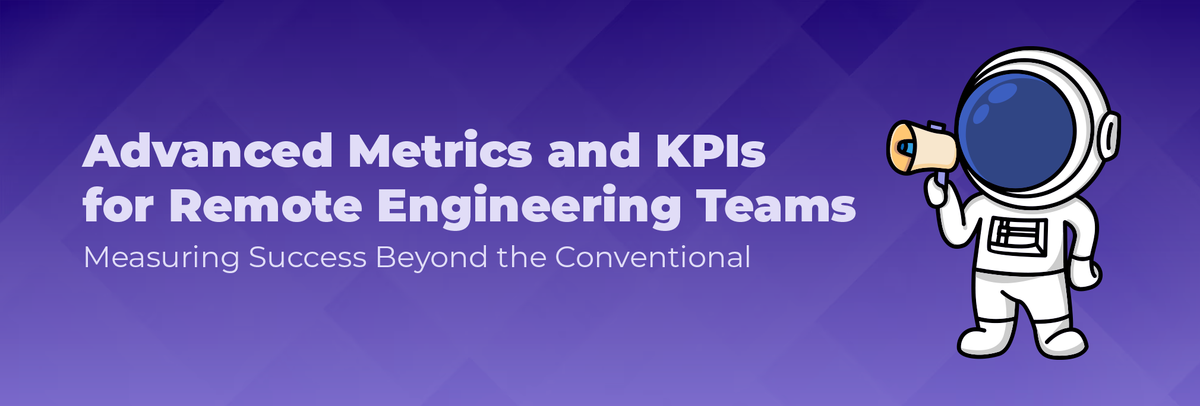Advanced Metrics and KPIs for Remote Engineering Teams: Measuring Success Beyond the Conventional

In the dynamic landscape of modern work, remote engineering teams have become the norm, transforming traditional office paradigms into virtual hubs of innovation.
Yet, measuring the success of these distributed teams requires a nuanced approach beyond conventional metrics.
Welcome to our exploration of "Advanced Metrics and KPIs for Remote Engineering Teams: Measuring Success Beyond the Conventional."
In this insightful journey, we delve into the intricate dynamics of remote, virtual, and distributed engineering teams, uncovering the key performance indicators (KPIs) and metrics essential for capturing their true impact.
Join us as we navigate the evolving terrain of remote collaboration and redefine success in the digital age.
What constitutes a Key Performance Indicator (KPI) in the realm of software development?
Despite strides in productivity, some teams still rely on intuition to navigate workflows, risking unforeseen setbacks in measurement and goal-setting.
To avert such oversights, teams benefit from defined objectives and strategic planning.
KPIs serve as vital benchmarks for assessing productivity and optimizing efficiency.
These indicators, ubiquitous in business, also inform software development's alignment with organizational goals.
While commonly tied to metrics like code volume, commits, and deployments, this traditional approach lacks precision and tangible objectives.
Thus, the efficacy of software development KPIs hinges largely on the specificity and relevance of their targets.
Exploring Advanced Metrics and KPIs for Remote Engineering Teams
- Employee Morale Indicators
Morale metrics offer engineering managers valuable insights into employee sentiments regarding the company and its leadership.
Unlike measurable metrics such as velocity, morale metrics are intangible, which may lead many engineering managers to undervalue them.
It's widely acknowledged that engineers who derive satisfaction from their work are more inclined to remain loyal to the organization.
Consequently, monitoring morale metrics becomes crucial in gauging employee retention.
According to a report by Gallup on employee engagement, organizations boasting a highly engaged workforce experience a 21% increase in profitability compared to those with lower engagement levels.
Additionally, they achieve 17% higher productivity levels than their counterparts with disengaged employees.
- Sprint Progress Visualization
Scrum, a popular framework for organizing product development, breaks down work into fixed time intervals known as Sprints, a practice widely adopted by software companies.
A pivotal component within this methodology is the sprint burndown chart, which visually represents the team's progress.
This chart illustrates completed work and remaining tasks, offering a clear snapshot of the team's workflow.
Ideally, it should reflect a consistent decrease, showcasing the diminishing number of tasks or work hours over time.
Employing the sprint burndown as a metric enables teams to monitor their performance against expectations, facilitating adjustments when necessary.
- Engineering Velocity Metrics
Engineering Velocity Metrics refers to the quantitative measurements used to assess the speed and efficiency of an engineering team in delivering work.
These metrics are crucial for understanding the pace of development, identifying bottlenecks, and predicting project timelines accurately.
One common metric used to measure engineering velocity is the number of story points completed within a specific time frame, typically a sprint in Agile development.
Story points represent the effort required to complete a user story or task, providing a standardized unit for estimation.
By tracking the velocity of story point completion over multiple sprints, teams can establish a baseline and predict future productivity.
Another velocity metric is cycle time, which measures the time taken for a task or user story to move through the development process from start to finish.
This metric helps identify areas of inefficiency and optimize workflows to reduce delivery times.
Engineering velocity metrics also encompass metrics related to code delivery, such as the frequency of deployments or lead time for changes to reach production.
These metrics reflect the team's ability to deliver value to customers quickly and continuously.
Overall, these metrics play a vital role in monitoring team performance, improving productivity, and enabling data-driven decision-making in software development projects.
- Code Churn
Code Churn, especially pertinent for remote engineering teams, quantifies the frequency and extent of changes made to the codebase over time.
In distributed environments, where coordination may be more challenging, monitoring code churn becomes crucial for maintaining code stability and team efficiency.
High code churn rates in remote settings could signal potential issues such as miscommunication, unclear requirements, or insufficient documentation.
Conversely, low churn rates may indicate stable codebases and effective collaboration practices.
For remote teams, leveraging version control systems and collaboration tools becomes imperative in tracking code churn accurately.
Regular code reviews and asynchronous communication channels also play pivotal roles in managing churn effectively.
By monitoring code churn metrics, remote engineering teams can identify areas for improvement, allocate resources more efficiently, and ensure the long-term maintainability and quality of their codebases.
- Code Review Efficiency
Code Review Efficiency is vital for remote engineering teams, where effective collaboration and communication are key to maintaining high-quality codebases.
This metric measures the speed and effectiveness of the code review process, from submission to approval.
In remote settings, where team members may be in different time zones or working asynchronously, efficient code reviews are essential for ensuring timely feedback and maintaining project momentum.
Delays or inefficiencies in the review process can lead to bottlenecks and hinder overall productivity.
Remote engineering teams can enhance code review efficiency by implementing clear guidelines and standards, utilizing automated code analysis tools to catch common issues, and leveraging collaboration platforms that facilitate asynchronous communication and code discussion.
Regular retrospectives and feedback loops can also help remote teams identify areas for improvement in the code review process and implement strategies to streamline workflows further.
By optimizing code review efficiency, remote engineering teams can foster a culture of collaboration, maintain code quality, and deliver high-quality software products efficiently, regardless of geographical barriers.
- Escaped Defects
For remote engineering teams, tracking Escaped Defects is paramount to ensuring the quality and reliability of their software products.
Escaped Defects refer to issues or bugs that are discovered by customers or end-users after a release has been deployed to production.
In the remote work environment, where face-to-face communication and oversight may be limited, the risk of defects escaping detection during development and testing stages increases.
By monitoring Escaped Defects, remote engineering teams can identify areas of weakness in their development, testing, and quality assurance processes.
This metric provides valuable feedback on the effectiveness of remote collaboration tools, communication channels, and testing methodologies employed by the team.
It also highlights potential gaps in requirements gathering, user acceptance testing, and regression testing efforts.
Furthermore, Escaped Defects impact customer satisfaction and erode trust in the product, which can have long-term consequences for the business.
Remote engineering teams must prioritize thorough testing, peer reviews, and automated testing frameworks to minimize the likelihood of defects escaping into production.
Additionally, fostering a culture of accountability and continuous improvement is essential for addressing and mitigating Escaped Defects effectively in remote work settings.
By actively monitoring and addressing Escaped Defects, remote engineering teams can uphold product quality standards, enhance customer satisfaction, and maintain a competitive edge in the market.
- Deployment Frequency
Deployment Frequency holds critical importance for remote engineering teams, reflecting their agility and responsiveness in distributed work environments.
High deployment frequency indicates swift integration, testing, and deployment of code changes, facilitating rapid adaptation to evolving requirements.
It enables remote teams to iterate quickly on features, reducing time-to-market for new releases and fostering continuous improvement based on real-time user feedback.
However, maintaining a balance between agility and stability is essential to ensure the reliability and performance of the software product.
Robust testing and monitoring practices are crucial in this regard.
By optimizing deployment processes and embracing a culture of continuous improvement, remote teams can leverage deployment frequency as a strategic advantage, enhancing their competitiveness and delivering value-driven solutions to end-users efficiently.
In conclusion, embracing advanced metrics and KPIs is paramount for remote engineering teams to thrive in today's dynamic landscape.
By leveraging these tools effectively, teams can enhance productivity, foster collaboration, and drive success beyond conventional measures, ultimately achieving their goals in the remote work environment.
Teamo: Your Gateway to the Best Remote Engineering Talent
Boost your business with Teamo's cutting-edge talent solution.
Access top-tier, pre-screened software developers from emerging markets, seamlessly integrated as remote powerhouses in your development team.
- Seamless Integration
- Fast and Affordable
- Extensively Vetted
GET STARTED!
Discover how easy it is to build your dream team with Teamo. Experience seamless integration, fast and affordable onboarding, and extensively vetted talent.
Ready to elevate your business? Get started with Teamo today.
FAQs
- How do advanced metrics benefit remote engineering teams compared to conventional ones?
Advanced metrics provide remote engineering teams with deeper insights into their performance, collaboration, and project outcomes, transcending the limitations of traditional metrics.
For remote software development teams, these metrics offer a comprehensive view of productivity, communication effectiveness, and team dynamics across geographically dispersed locations.
Unlike conventional metrics, advanced metrics take into account the unique challenges and opportunities presented by remote work, allowing teams to optimize their processes, identify areas for improvement, and ultimately enhance their overall performance and success.
- What are some best practices for measuring success in remote engineering projects?
Measuring success in remote engineering projects requires a combination of metrics tailored to the specific needs and dynamics of remote tech teams.
Key best practices include establishing clear goals and objectives, fostering effective communication and collaboration channels, leveraging appropriate remote engineering tools and technologies, regularly tracking and analyzing relevant metrics, and proactively addressing any challenges or bottlenecks that may arise.
By adopting these best practices, remote engineering teams can ensure alignment with project goals, maximize productivity, and deliver high-quality outcomes consistently.
- What challenges do remote engineering companies commonly face when implementing advanced metrics?
Remote engineering companies may encounter several challenges when implementing advanced metrics, including remote engineering culture, communication barriers, and selecting appropriate tools for tracking and analyzing metrics.
Additionally, ensuring data accuracy and reliability across distributed teams, maintaining transparency and accountability in metric reporting, and overcoming resistance to change are common hurdles that organizations may face.
However, by addressing these challenges proactively and investing in robust processes, training, and infrastructure, remote engineering companies can successfully harness the power of advanced metrics to drive performance and success.
- How can remote engineering companies foster a culture of success with advanced metrics?
Fostering a culture of success with advanced metrics in remote engineering companies requires leadership buy-in, employee engagement, and a commitment to data-driven decision-making.
Leaders should communicate the importance of advanced metrics in driving performance and achieving organizational goals, while also providing the necessary resources, training, and support to enable teams to leverage these metrics effectively.
Additionally, promoting a culture of transparency, collaboration, and continuous improvement encourages employees to actively participate in metric tracking, analysis, and optimization efforts.
By fostering such a culture, remote engineering companies can create an environment where advanced metrics become integral to driving success and innovation across the organization.




